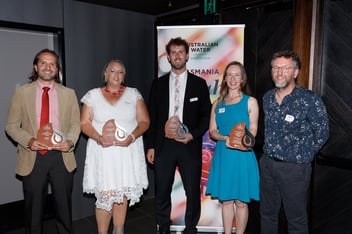Innovative approaches put Tasmanian farmers in the running for irrigation award
Tasmania’s Greenvale Pastoral is in the running to win an international sustainable irrigation award for its work in adopting innovative water management technologies.
Cressy farmers Robbie and Eliza Tole have been shortlisted for the Zimmatic Trailblazer Sustainable Irrigation Awards, which aim to celebrate farming excellence and create a platform to communicate how farmers are leading the way in responsible irrigation.
Robbie Tole said the technology used at Greenvale Pastoral has been around for some time, but adopting various innovations in irrigation management has led to more sustainable use of water and power, as well as maximising crop yields.
“We use variable rate irrigation [VRI] technology. One of the biggest benefits, in terms of surface water management, is the control we have on irrigator nozzles. It helps us water paddocks with varied elevation and different soil types with a lot more precision,” he said.
“For example, we’ve got areas in the paddock that are lower than other areas. These areas might only need 4 mls of water, but the high banks might need 10 mls.
“If you’ve got an irrigator that applies 10 mls of water across an entire paddock, you end up over watering some areas, which get wetter and wetter, and the health of the crop in that section of the paddock diminishes.
“WIth VRI technology, we are able to apply the right amount of water to each section of the paddock to ensure maximum crop yield. The irrigator nozzles have a four-metre radius throw. This means that for every four metres of paddock, we can control the exact amount of water applied.”
Terra technology
Tole said Greenvale Pastoral has also invested in technology and equipment to help with paddock drainage, which has, in turn, led to the beginning of a small contracting business helping other farmers manage surface water.
“The technology and equipment allows us to manage surface water drainage, which is all GPS-controlled. It identifies the accurate elevation of the paddock, which helps draw up drainage designs. That program is called Terra Design,” Tole said.
“We collect elevation data from the paddock with in-cab GPS, which allows for about 1 cm accuracy. This allows us to break the paddock up into different regions and zones.
“In conjunction with Terra Design, we also use an in-cab program on a tablet, called Terra Cutter. It gives us a 3D-image of the paddock, connected to our computer. It controls the hydraulic ram on the blade that we draw across the paddock, which cuts the soil accordingly, pulling it from one area to another, which results in a more even grade.
“We utilised the program on our own paddocks, but we are not just doing it for ourselves, we are now helping other farmers in the area with their surface water management too.”
Information for irrigation
But in terms of managing their own paddocks, Tole said Greenvale Pastoral also uses other real-time technology, including moisture probes and localised weather monitoring, which he controls from his phone.
“Instead of going out into the paddock with a spade everyday to figure out soil moisture, I can log in to my phone and receive a live reading whenever I like,” he said.
“The local weather station is about 10 kilometres away. But the wind and rainfall recorded there is different to where we are. It makes it very hard to plan irrigation from weather stations that aren’t on site. But now we’ve effectively got a weather station in every paddock, measuring soil moisture, temperature and rainfall.
“We know evaporation rates and plant usage. If we get a rain event, we know exactly how much has fallen in that paddock, which helps us figure out when we need to water again. This is hugely beneficial in terms of saving water.
“It is also very helpful in re-starting irrigation again on time, making sure we don’t fall behind on watering. It allows us to plan. It’s been a pretty big change for us.”
And while the technology has helped create more sustainable irrigation practices, Tole said he is sure the best is yet to come.
“It’s become the norm for us now. There’s no way I could go back,” Tole said.
“The exciting thing is what’s to come. Technology is always changing and there is a lot of R&D going into this technology all the time. I’m looking forward to seeing what else we can do with it in future.”

